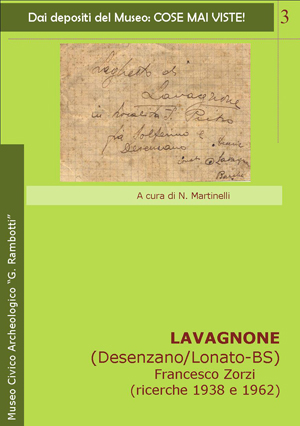Small exhibitions to discover the materials kept in the Museum's storerooms.
For smaller complexes, in terms of the number of finds, or for particularly significant individual objects that do not find space in the museum itinerary, the Museum, starting in 2018, has introduced the exhibition initiative "Dai depositi del Museo: COSE MAI VISTE!" (From the Museum's storerooms: THINGS NEVER SEEN!) for which a showcase is set up, supported by an educational panel and a small guidebook that can be downloaded from this page.
3-2022From 20 May 2022
LAVAGNONE (Desenzano/Lonato-BS). Francesco Zorzi (ricerche 1938 e 1962)
The exhibition is dedicated to the finds discovered by Francesco Zorzi (1900-1964), a scholar of prehistory and director of the Museo Civico di Storia Naturale di Verona, at Lavagnone.The materials exhibited here until 2017 were kept at the Museo Civico di Storia Naturale di Verona.
The catalogue is edited by Nicoletta Martinelli.
2,2020
LAVAGNONE (Desenzano/Lonato-BS). Scavi dell'Università degli Studi di Milano nel settore E
The exhibition is dedicated to artefacts found in a drainage unit extended over almost the entire excavation area (sector E), between 2011 and 2015 during the research campaigns of the University of Milan at the Lavagnone site.
Based on the stratigraphy and the characteristics of the finds, the reclamation dates back to an already advanced stage of the Middle Bronze I (ca. 1625-1525 BC). At that time, the settlement extended between the north-eastern shore and the centre of the basin, including both pile dwellings in the still wet areas and houses on dry land. Archaeological finds also testify to the existence of exchanges with other groups in northern Italy, such as the Western pile-dwellings culture in the province of Varese and the Terramare culture in Emilia.
The presence of the remains of a human skull at the base of the unit can be interpreted as a votive deposition in the foundation clearing of the next settlement level.
1, 2019
Maguzzano (Lonato-BS)
Until 2018, the materials from Maguzzano were kept in Brescia at the Museo Civico di Storia Naturale. They have now become part of the museum's collections, thanks to an agreement between the Bergamo-Brescia Superintendency and the municipality of Desenzano del Garda aimed at strengthening the city museum as a cultural centre for the Desenzano area..
The materials, especially the pottery, allow us to assume the presence of a village built at the end of the Early Bronze Age (end of IXX-mid 17th century BC) and abandoned at the beginning of the Middle Bronze Age (mid 17th-mid 16th century BC).








